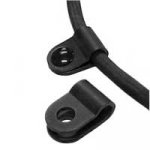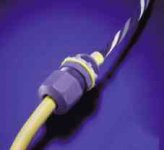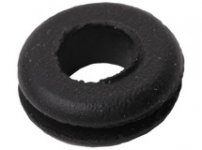Using cable grommets for mains leads?
Can you still use mains leads and drilling a hole into your chassis then putting in rubber grommets instead of IEC sockets?
I'm going to tie it down inside my project with a cable fastener aka R-type cable clamp (that mounts to the chassis with a bolt, same bolt can then be used for an earth) so the cable doesn't come out.
Or should I simply use waterproof cable glands? I really don't want to have to make another IEC socket hole... then again I have been using a nibbling tool to make those holes. are there cheap IEC hole punches?
Can you still use mains leads and drilling a hole into your chassis then putting in rubber grommets instead of IEC sockets?
I'm going to tie it down inside my project with a cable fastener aka R-type cable clamp (that mounts to the chassis with a bolt, same bolt can then be used for an earth) so the cable doesn't come out.
Or should I simply use waterproof cable glands? I really don't want to have to make another IEC socket hole... then again I have been using a nibbling tool to make those holes. are there cheap IEC hole punches?
Attachments
Last edited:
Grommet and clamp probably will not meet many of the different world standards, but actual testing would be required.
Weatherproof cable clamp will be marked with the appropriate approvals and would be good under most standards.
IEC cord and socket is intended to allow a compliant power cord to be provided to meet all of the various standards. Not really needed for DIY.
As to an inexpensive chassis punch, depends on your idea of inexpensive. Some folks use a Greenlee 731R for under $150.00.
Weatherproof cable clamp will be marked with the appropriate approvals and would be good under most standards.
IEC cord and socket is intended to allow a compliant power cord to be provided to meet all of the various standards. Not really needed for DIY.
As to an inexpensive chassis punch, depends on your idea of inexpensive. Some folks use a Greenlee 731R for under $150.00.
Can you still use mains leads and drilling a hole into your chassis then putting in rubber grommets instead of IEC sockets?
I'm going to tie it down inside my project with a cable fastener aka R-type cable clamp (that mounts to the chassis with a bolt, same bolt can then be used for an earth) so the cable doesn't come out.
Or should I simply use waterproof cable glands? I really don't want to have to make another IEC socket hole... then again I have been using a nibbling tool to make those holes. are there cheap IEC hole punches?
No.
As far as I'm aware, earth bolts must be their own device.
As in a bolt purely for the earth.
Using a plastic (deformable) anything under an earth bolt can never be a good idea.
Think theres also something about having to use a spring washer ?
What is a step drill?
Perfect holes. A little liquid/oil while drilling helps cool it.
Perfect holes. A little liquid/oil while drilling helps cool it.
For a secure chassis ground, (6-8mm bolt) use star washers on both sides of the bolt, dab of grease (heatsink?) to "seal" the interface...the steel teeth on the washer digs into the chassis material, the grease seals the connection against Oxygen which can be a source of reaction from the dissimilar metals.
----------------------------------------------------------------------------Rick..........
----------------------------------------------------------------------------Rick..........
Step drills are not without their own issues of control, particularly in stock that is thinner than the steps, and as for the Greenlee punches - well there's more than one size of IEC input - i.e. with or without fuses and/or switches, etc.
For hand-bombed projects, I always use aluminum chassis, which drill easily enough with standard twist bits, and consider the time spent with small precision files as therapy.
For hand-bombed projects, I always use aluminum chassis, which drill easily enough with standard twist bits, and consider the time spent with small precision files as therapy.
I've seen old rubber cable grommets that had gone brittle and fallen apart sufficiently to allow the cable to then abrade on the sharp metal edge of the hole, until the copper wire inside was exposed. 
I loathe having to cut those irregular hexagonal holes in sheet metal for IEC receptacles. But I do think it's much safer than a cable grommet, particularly in the long term. (Though today's plastic cable grommets might be safer.)
I've found some IEC receptacles that also incorporate a fuse, and an on/off switch, and which fit quite well if you cut a simple rectangular hole in the chassis metal. The bigger flange on these allows this.
It may be worth noting that IEC cords can usually be found easily just about anywhere. Powercons? Not so much. In fact, I've never seen one!
Cheap step-drills are likely to be found at your local cheap Chinese tool importer, if there is such a thing in your corner of Australia. In my experience, they don't wear as well as Greenlees and Milwaukees and other premium tools, but the cost difference is significant, and the cheap ones will probably last many last years with the amount of use they get from DIY amp building.
-Gnobuddy
I loathe having to cut those irregular hexagonal holes in sheet metal for IEC receptacles. But I do think it's much safer than a cable grommet, particularly in the long term. (Though today's plastic cable grommets might be safer.)
I've found some IEC receptacles that also incorporate a fuse, and an on/off switch, and which fit quite well if you cut a simple rectangular hole in the chassis metal. The bigger flange on these allows this.
It may be worth noting that IEC cords can usually be found easily just about anywhere. Powercons? Not so much. In fact, I've never seen one!
Cheap step-drills are likely to be found at your local cheap Chinese tool importer, if there is such a thing in your corner of Australia. In my experience, they don't wear as well as Greenlees and Milwaukees and other premium tools, but the cost difference is significant, and the cheap ones will probably last many last years with the amount of use they get from DIY amp building.
-Gnobuddy
For fixed connections with lighter gauge power cable, there's always the Heyco strain relief grommets. Being nylon, they're not susceptible to the same degradation as rubber, but they still also need a non circular panel opening . Strain Relief Bushings | Power Cord Strain
I think they were pretty much a standard in mainstream consumer electronics for decades, until the advent of the IEC.
There's a helluva range of sizes and shapes of IEC receptacles, my favorite is probably the small one with integral fuse holder - some models with switches are huge, and if cutting openings by hand can take a fair bit of time, particularly in steel panels.
I think they were pretty much a standard in mainstream consumer electronics for decades, until the advent of the IEC.
There's a helluva range of sizes and shapes of IEC receptacles, my favorite is probably the small one with integral fuse holder - some models with switches are huge, and if cutting openings by hand can take a fair bit of time, particularly in steel panels.
This is what I just used on a 35 year old amp to replace the dried up lamp cord with 12-3 on an amp.
1497 Heyco | Mouser
Had to enlarge the hole in the case to .875 Dia.
1497 Heyco | Mouser
Had to enlarge the hole in the case to .875 Dia.
I went down to bunnings today and got myself some star washers and some M5 screws and bolts and some eyelets and some AU plugs and some fine files. Also got some Sutton tools Viper drill bits, 1mm-10mm with no gaps in the sizes.
I also ordered some stainless steel PG7 4-6mm waterproof cable grommets:
6 Pcs PG7 Metal Waterproof Locknut Stuffing Cable Gland Connector | eBay
Also ordered a step drill a week ago.
I also ordered some stainless steel PG7 4-6mm waterproof cable grommets:
6 Pcs PG7 Metal Waterproof Locknut Stuffing Cable Gland Connector | eBay
Also ordered a step drill a week ago.
Last edited:
This is what I just used on a 35 year old amp to replace the dried up lamp cord with 12-3 on an amp.
1497 Heyco | Mouser
Had to enlarge the hole in the case to .875 Dia.
Almost exactly the part I can remember as part of the Hafler kits of which I built literally hundreds for a local hifi shop back in the mid 70s- early 80's - even the 500 used them . Now, unlike the small preamps, that was not a product you'd want to drag around by the power cord. While 45lbs might not seen overkill in today's market, it was still a brute to build.
.jpg)
- Status
- This old topic is closed. If you want to reopen this topic, contact a moderator using the "Report Post" button.
- Home
- Design & Build
- Construction Tips
- Using cable grommets for mains leads? Still legal?


